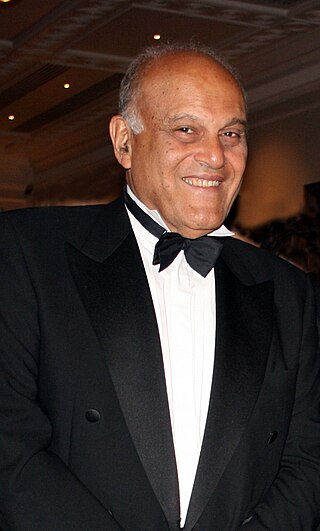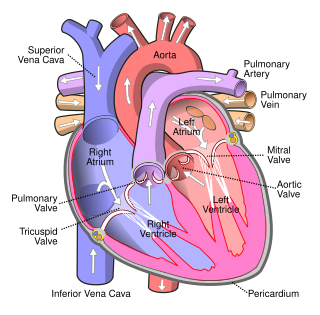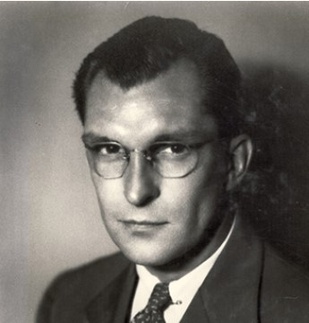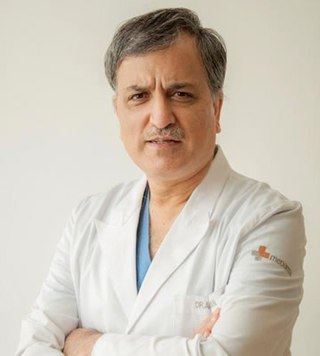Giuseppe Di Benedetto | |
|---|---|
| Born | January 8, 1946 Eboli, Italy |
| Education | University of Perugia University of Bergamo University Hospital in Washington |
| Known for | development of Minimally invasive cardiac surgery, first operation of ever of correction of Tetralogy of Fallot complications |
| Medical career | |
| Profession | Surgeon |
| Institutions | Ospedali Riuniti San Giovanni di Dio e Ruggi D'Aragona Providence Hospital Kinderklinik of Bonn Great Ormond Street Hospital |
| Sub-specialties | Cardiovascular surgery |
| Research | Cardiac surgery techniques |
Giuseppe Di Benedetto is an Italian cardiac surgeon born in Eboli on 8 January 1946, He holds the Italian national record for the use of carbon dioxide laser to perform revascularization trans-myocardial otherwise inoperable; specialized in congenital diseases of cardiovascular system, is one of the few surgeons in the world that practice successfully the surgery of aortic arch. [1] [2]
In particular, on October 30, 2014, for the first time in the world he has successfully performed a complex operation on a patient with tetralogy of Fallot who had had complications. Accomplishes still research of international interest such as the coronary surgery minimally invasive developed by him and on which he has held two major international conferences. [3]
Born January 8, 1946, in Eboli by Pasquale Di Benedetto and Carmela Botta, the youngest of seven children, Giuseppe Di Benedetto obtained a degree in Medicine to Perugia University with a thesis on "chemical carcinogenesis" with 110 and praise in 1972. He obtained a degree at the center of pediatric cardiac surgery of Bergamo directed by Lucio Parenzan which at the time was the largest center for pediatric cardiac surgery in the world.
In 1974 left for a Master in United States that lasted three years, during which up to 1975 was responsible for the research laboratory cardiovascular at the University Hospital in Washington and from 1976 to 1977 held the role of director of cardiovascular physiology at Providence Hospital in Seattle. [4] After that Di Benedetto, will work from 1978 to 1981 as assistant of the professor Lucio Parenzan in Bergamo. [5]
Returned from 'America married Liliana Verdoni, a journalist who come from Bergamo, and they had two daughters. In 1981 moved to London for six months at the "Great Ormond Street Hospital for sick children" which at that time was one of the most important centers of pediatric cardiac surgery of the world.
In 1981 returned Italy as the first aid of Professor Ugo Tesler to Hospital San Carlo of Potenza where he created the department of cardiac pediatric to prevent children from southern Italy were forced to travel to Bergamo to be operated. [6] In 1984 left for Bonn in Germany where he became the director of the department of pediatric cardiac surgery hospital "Kinderklinik"; after a year he decided to come back to Italy at the San Carlo Hospital of Potenza with the same assignment. In 1990 won the chief contest held in Padua and in the 1991 began to serve in Salerno, where he established the department of cardiac surgery. [7] On December 19, 1991, Di Benedetto had to operate in emergency, he made a substitution of thoracic aorta in a patient of 60 years with an fissured aneurysm without the aid of the machine for extracorporeal circulation which was necessary for the intervention; he performed a shunt subclavian-femoral that made possible the perfusion marrow. The operation was successful at the point that the patient was discharged after only ten days, and began the development of the new technique of the beating heart. [8]
From 1993 began at full time the business of cardiac surgery at the Ospedale S. Giovanni di Dio e Ruggi d’Aragona Salerno. [9] In 2000 he was invited by Professor Alan Carpentier of Paris European inauguration of the hospital "Georges Pompidou" where they had gathered the greatest exponents of cardiac surgery worldwide, including Christiaan Barnard and Denton Cooley. [10]
With the intensification of the activity and with increasing fame of the cardiac surgery of Salerno the waiting time for an intervention began really long; they need a new larger hospital with new technologies. Work began to build the "Tower of the Heart", but after repeated promises relating to the opening of the Tower were often disregarded, Giuseppe Di Benedetto clashed with the administrative commission to the point of threatening to abandon Salerno. [11]
Everything turned out for the better when finally, on 24 September 2007 was inaugurated the Tower of cardiology of Ospedale S. Giovanni di Dio e Ruggi d’Aragona of Salerno. [12] Professor Giuseppe Di Benedetto refused offers from a clinic in Switzerland and from a hospital of Roman [13] to take over the "Tower of The Heart" one of the centers of excellence of Italian cardiac surgery. [14] Prof. Giuseppe Di Benedetto was elected Chairperson of the National Association of Medical and Surgeon Cardiology ANMCO [15] and under his direction the department of cardiac surgery won the bronze medal in the S.T.I.C.H. "Surgical Treatment of Ischemic Failure" which was attended by 96 centers around the world. [16]
During years a lot of new innovative surgical techniques were developed by Di Benedetto and his associates. The most important are: myocardial revascularization which involves only the use of arterial ducts ; the surgical technique of beating heart (I.e. without the use of machines for extracorporeal circulation) that allows a percentage of revascularization over 90%; the development of minimally invasive surgery related to both coronary and valves (on which he organized two international conferences in 1997 and 1998) and development of conservation valves techniques in collaboration with the American professor Tirone David. [17]
In 1995 performed a rare surgery correction known as isolated congenital inversion atrial in situs inversus on a girl of only five days. As one of the few surgeon in the world to have successfully performed this surgery, he collaborated to an article annuals of surgery chest of 1995.
In 1996 the use for the first time in Italy of carbon dioxide laser for trans-myocardial revascularization, otherwise impossible, Di Benedetto be the focus of all the national television networks. [18] [19]
On July 31, 2009, worked together with Luciano Brigante a patient with giant aneurysm of the internal left carotid artery. This type of intervention had been carried out only in three other centers in the world that Phoenix, Helsinki and Milan. [20]
In 2011 was one of the few in Europe to have performed two successful interventions of replacement of aortic valves with prosthesis of the last generation that do not require sutures. On December 6, 2010, put at the disposal of 'Italian Association against leukemia-lymphoma and myeloma on the third floor of the Tower of Cardiology allowing the establishment of the Salerno AIL . [21]
On 30 October 2014 Giuseppe Di Benedetto has performed for the first time in the world a complicated surgery correction of complications due to the tetralogy of Fallot. Domenico Bisaccia student Medicine of the fourth year at the 'University of Salerno had a aneurysm of the aortic arch ascending and a' valvular insufficiency of both aortic valve and pulmonary valve. During only an intervention Di Benedetto was able to remove the aneurysm, implant the aortic valve using the patient's own tissues and replace the pulmonary valve with a trans ventricular valve of last generation, which does not require sutures, never been used for this purpose. [22] [23] [24]
Di Benedetto cooperates with leading international cardiac surgeons. In 1995 there was the twinning Salerno - Tokyo for Research and Professor Hisayoshi Suma [25] was a guest in Salerno at the Tower Cardiological to teach the new heart surgery technique he had developed. [26]
Few years later with Professor Alan Carpentier of the Parisian school there was an agreement for the constant exchange of professional experiences; Professor Kim A. Eagle, famous researcher American, Di Benedetto asked to write a chapter on his book "Aortic dissection and related syndromes" dedicated to aortic dissection. [27]

Interventional cardiology is a branch of cardiology that deals specifically with the catheter based treatment of structural heart diseases. Andreas Gruentzig is considered the father of interventional cardiology after the development of angioplasty by interventional radiologist Charles Dotter.

Cardiac surgery, or cardiovascular surgery, is surgery on the heart or great vessels performed by cardiac surgeons. It is often used to treat complications of ischemic heart disease ; to correct congenital heart disease; or to treat valvular heart disease from various causes, including endocarditis, rheumatic heart disease, and atherosclerosis. It also includes heart transplantation.
Aortic valve replacement is a cardiac surgery procedure whereby a failing aortic valve is replaced with an artificial heart valve. The aortic valve may need to be replaced because of aortic regurgitation, or if the valve is narrowed by stenosis.

Sir Brian Gerald Barratt-Boyes was a pioneering New Zealand cardiothoracic surgeon. He was known for early development of cardiopulmonary bypass surgery, early implantation of a cardiac pacemaker before these devices became commercially available in 1961, early use of human cadaveric aortic homografts for aortic valve replacement, and introduced the use of hypothermia and cardiac arrest for surgery in neonates and infants.

Sir Magdi Habib Yacoub is an Egyptian-British retired professor of cardiothoracic surgery at Imperial College London, best known for his early work in repairing heart valves with surgeon Donald Ross, adapting the Ross procedure, where the diseased aortic valve is replaced with the person's own pulmonary valve, devising the arterial switch operation (ASO) in transposition of the great arteries, and establishing the heart transplantation centre at Harefield Hospital in 1980 with a heart transplant for Derrick Morris, who at the time of his death was Europe's longest-surviving heart transplant recipient. Yacoub subsequently performed the UK's first combined heart and lung transplant in 1983.
Tirone Esperidiao David, is a Brazilian-born Canadian cardiac surgeon and professor of surgery at the University of Toronto. He is an attending cardiac surgeon at the Peter Munk Cardiac Centre, Toronto General Hospital. He is known for his 2007 development of a valve sparing aortic root replacement procedure to preserve the aortic valve in patients with aortic root aneurysms such as in Marfan syndrome; it is now known as the "David Operation".

Mitral valve repair is a cardiac surgery procedure performed by cardiac surgeons to treat stenosis (narrowing) or regurgitation (leakage) of the mitral valve. The mitral valve is the "inflow valve" for the left side of the heart. Blood flows from the lungs, where it picks up oxygen, through the pulmonary veins, to the left atrium of the heart. After the left atrium fills with blood, the mitral valve allows blood to flow from the left atrium into the heart's main pumping chamber called the left ventricle. It then closes to keep blood from leaking back into the left atrium or lungs when the ventricle contracts (squeezes) to push blood out to the body. It has two flaps, or leaflets, known as cusps.
A vascular bypass is a surgical procedure performed to redirect blood flow from one area to another by reconnecting blood vessels. Often, this is done to bypass around a diseased artery, from an area of normal blood flow to another relatively normal area. It is commonly performed due to inadequate blood flow (ischemia) caused by atherosclerosis, as a part of organ transplantation, or for vascular access in hemodialysis. In general, someone's own vein (autograft) is the preferred graft material for a vascular bypass, but other types of grafts such as polytetrafluoroethylene (Teflon), polyethylene terephthalate (Dacron), or a different person's vein (allograft) are also commonly used. Arteries can also serve as vascular grafts. A surgeon sews the graft to the source and target vessels by hand using surgical suture, creating a surgical anastomosis.

Transcatheter aortic valve implantation (TAVI) is the implantation of the aortic valve of the heart through the blood vessels without actual removal of the native valve. The first TAVI was performed on 16 April 2002 by Alain Cribier, which became a new alternative in the management of high-risk patients with severe aortic stenosis. The implantated valve is delivered via one of several access methods: transfemoral, transapical, subclavian, direct aortic, and transcaval, among others.

Annuloaortic ectasia is characterized by pure aortic valve regurgitation and aneurysmal dilatation of the ascending aorta. Men are more likely than women to develop idiopathic annuloaortic ectasia, which usually manifests in the fourth or sixth decades of life. Additional factors that contribute to this condition include osteogenesis imperfecta, inflammatory aortic diseases, intrinsic valve disease, Loeys-Dietz syndrome, Marfan syndrome, and operated congenital heart disease.

Marian Ion Ionescu was a Romanian-born British cardiac surgeon. His interest in heart surgery covered several aspects of this specialty. He was an inventor of surgical devices, mostly artificial heart valves, a scientist in the broad term and a medical educator. Ionescu died on 12 October 2023, at the age of 94.
The German Hospital Tirana is a hospital in Tirana, Albania.

A hybrid cardiac surgical procedure in a narrow sense is defined as a procedure that combines a conventional, more invasive surgical part with an interventional part, using some sort of catheter-based procedure guided by fluoroscopy imaging in a hybrid operating room (OR) without interruption. The hybrid technique has a reduced risk of surgical complications and has shown decreased recovery time. It can be used to treat numerous heart diseases and conditions and with the increasing complexity of each case, the hybrid surgical technique is becoming more common.
Donald Nixon Ross, FRCS was a South African-born British thoracic surgeon who was a pioneer of cardiac surgery and led the team that carried out the first heart transplantation in the United Kingdom in 1968. He developed the pulmonary autograft, known as the Ross procedure, for treatment of aortic valve disease.

Nina Starr Braunwald was an American thoracic surgeon and medical researcher who was among the first women to perform open-heart surgery. She was also the first woman to be certified by the American Board of Thoracic Surgery, and the first to be elected to the American Association for Thoracic Surgery. In 1960, at the age of 32, she led the operative team at the U.S. National Institutes of Health (NIH) that implanted the first successful artificial mitral human heart valve replacement, which she had designed and fabricated.
Michael J. Reardon is an American cardiac surgeon and medical researcher. He is known for his work in heart autotransplantation for malignant heart tumors, an operation in which the surgeon removes the patient's heart, cuts out the malignant tumor, and reimplants the heart back in the patient's chest. He performed the first successful heart autotransplantation for a cancerous heart tumor in 1998.

Horace Gilbert Smithy Jr. was an American cardiac surgeon who in 1948 performed the first successful mitral valve repair since the 1920s. Smithy's work was complicated because it predated heart-lung machines or open heart surgery. Though his procedure did not become a definitive treatment for valvular heart disease, he introduced the technique of injecting novocaine into the heart to avoid arrhythmias during surgery, and he showed that it was feasible to access and operate on the heart's valves.
Marjan Jahangiri FRCS, FRCS (CTh) is Professor of Cardiac Surgery at St. George's Hospital, University of London. She was the first woman to be appointed professor of cardiac surgery in the United Kingdom and Europe.

Dr. Anil Bhan is the Chairman of Cardiac Surgery Heart Institute, Medanta Hospital, Gurugram, India. He graduated from Medical College Srinagar. He has the largest experience in aortic surgery in India since he has designed and developed more than 50 surgical instruments in the field of cardiac surgery. He was one of the team members to perform the first successful heart transplant in India in1994. He served as a co-founder of Max Heart and Vascular Institute, Saket, New Delhi, Director and Chief Co-Ordinator, Cardio thoracic and Vascular Surgery, MHVI, Saket.Additional Professor, Cardiothoracic Surgery and Vascular Surgery, AIIMS, New Delhi.
John D. Puskas is an American researcher, author, inventor and cardiovascular surgeon. As of 2022, he is Professor, Cardiovascular Surgery, Icahn School of Medicine at Mount Sinai, and chairman, Department of Cardiovascular Surgery at Mount Sinai Morningside, Mount Sinai Beth Israel and Mount Sinai West. He holds 11 U.S. patents and co-founded the International Coronary Congress and the International Society for Coronary Artery Surgery. He is credited by ResearchGate with 330 publications and 15,234 citations and as of 2022 Scopus reports an h-index of 62. Puskas is known for advancing coronary artery bypass (CABG) surgery by refining surgical techniques for all-arterial, off-pump CABG and inventing finer instruments to be used for advanced coronary bypass surgical procedures. He is credited with performing the first totally thoracoscopic bilateral pulmonary vein isolation procedure. He is the co-editor of State of the Art Surgical Coronary Revascularization, the first textbook solely devoted to coronary artery surgery.